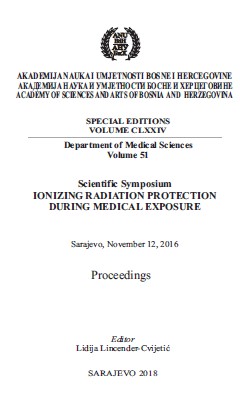OPRAVDANOST MEDICINSKE EKSPOZICIJE I KRITERIJA ZA UPUĆIVANJE NA RADIOLOŠKE PRETRAGE
JUSTIFICATION OF MEDICAL EXPOSURE AND CRITERIA FOR REFERRAL TO DIAGNOSTIC IMAGING
Author(s): Lidija Lincender-Cvijetić
Contributor(s): Svjetlana Baroševčić (Translator)
Subject(s): Health and medicine and law
Published by: Akademija Nauka i Umjetnosti Bosne i Hercegovine
Keywords: ionizing radiation; radiology; radiation protection;
Summary/Abstract: Aim of the article: To draw attention to justification of medical exposure in the application of ionizing radiation, as well as to the necessity of ionized radiation protection through the application of existing regulations. This study refers to the application of ionizing radiation for medical purposes, justification of medical exposure, criteria for referral to diagnostic imaging, and ionizing radiation protection. The protection is based on the opinion that diagnostic imaging is justified and useful for patients. Balance between digital techniques and radiation dose the patient receives is very important in digital techniques. Nowadays, diagnostic imaging procedures present one of the largest artificial sources of ionizing radiation of the population in medicine. Proper selection of diagnostic imaging procedures and monitoring of the disease can influence setting the final diagnosis and application of adequate treatment. It is necessary to avoid duplication and repetition of diagnostic imaging procedures using ionizing radiation. Special importance in diagnostic imaging procedures applied to both adults and children requires knowledge of imaging procedure possibilities, their adequate application and education of radiology engineers. The most important is the safety of the patient in the application of necessary radiology procedures (imaging techniques and exposures) which is achieved by adequate protection and immobilization. Professional staff must adhere to ionizing radiation protection measures in the field of imaging diagnostics, nuclear medicine and radiotherapy. Compliance with ALARA (As Low as Reasonably Achievable) principles issued by European Agency for Protection against Ionizing Radiation and application of regulations of the State Regulatory Agency for Radiation and Nuclear Safety can significantly reduce the radiation dose without losing diagnostic information. Application of the specific levels of radiation doze for each particular imaging as an “accepted level” along with regular quality control of diagnostic and therapeutic procedures can assist in the protection against radiation in radiology, in justified application of diagnostic imaging and therapeutic procedures. Conclusion: By the adequate application of diagnostic imaging procedures based on strict clinical indications, by modifying the existing regulations and protection means, as well as by continuously educating radiologists, general practitioners, specialists and medical radiology engineers, we can contribute to decreasing the risk when it comes to changes in ionizing radiation in medicine.
Book: ZAŠTITA OD JONIZIRAJUĆEG ZRAČENJA KOD MEDICINSKE EKSPOZICIJE
- Page Range: 7-12
- Page Count: 6
- Publication Year: 2018
- Language: Bosnian, Croatian, Serbian
- Content File-PDF

